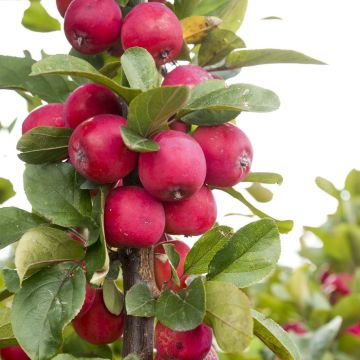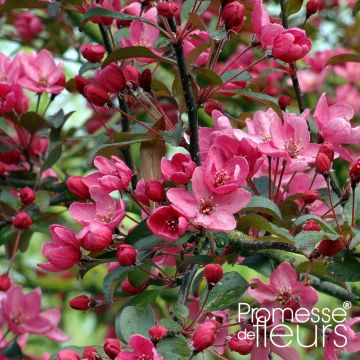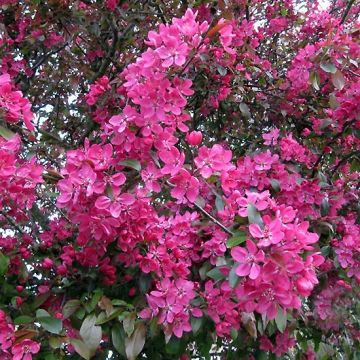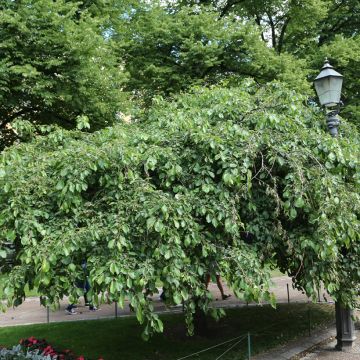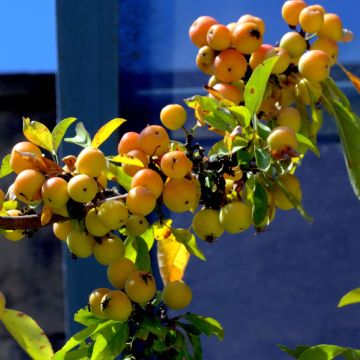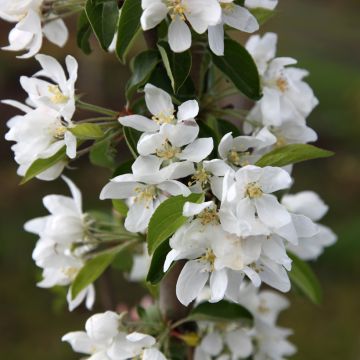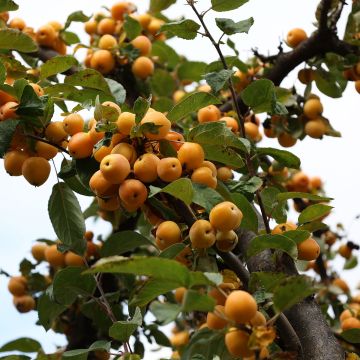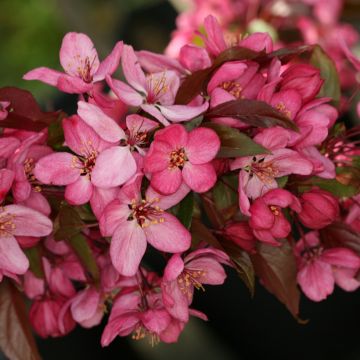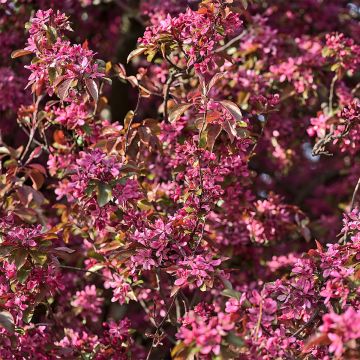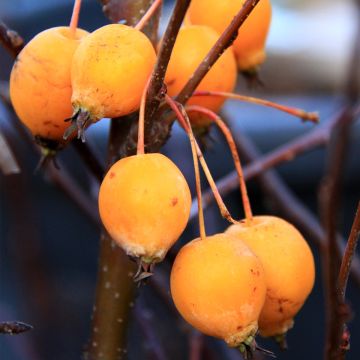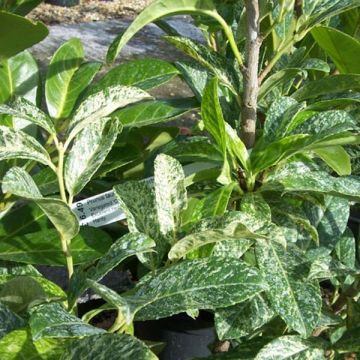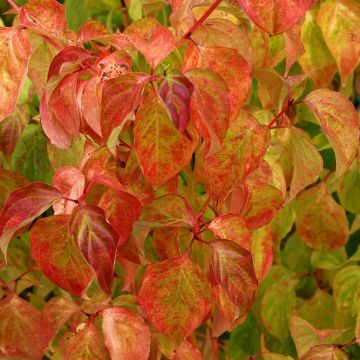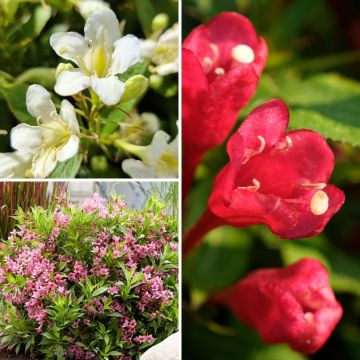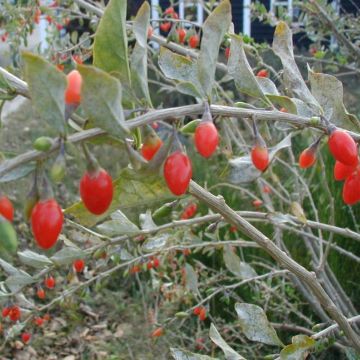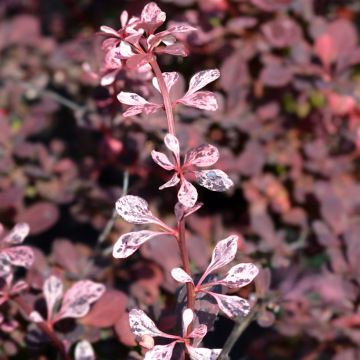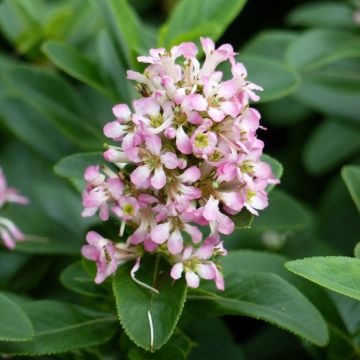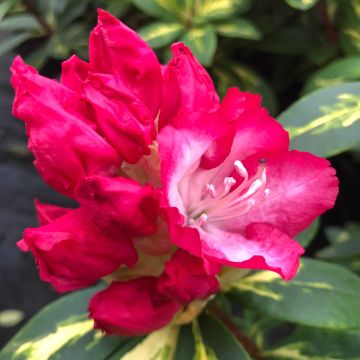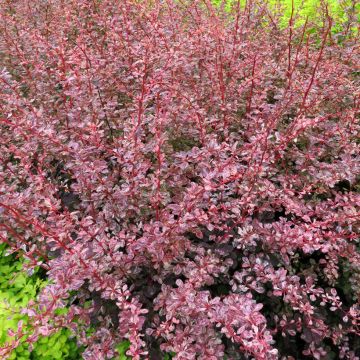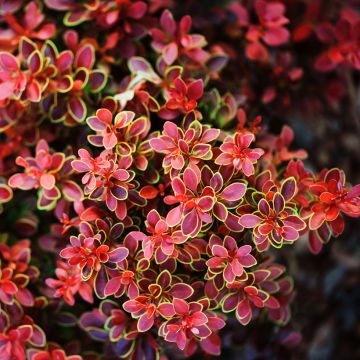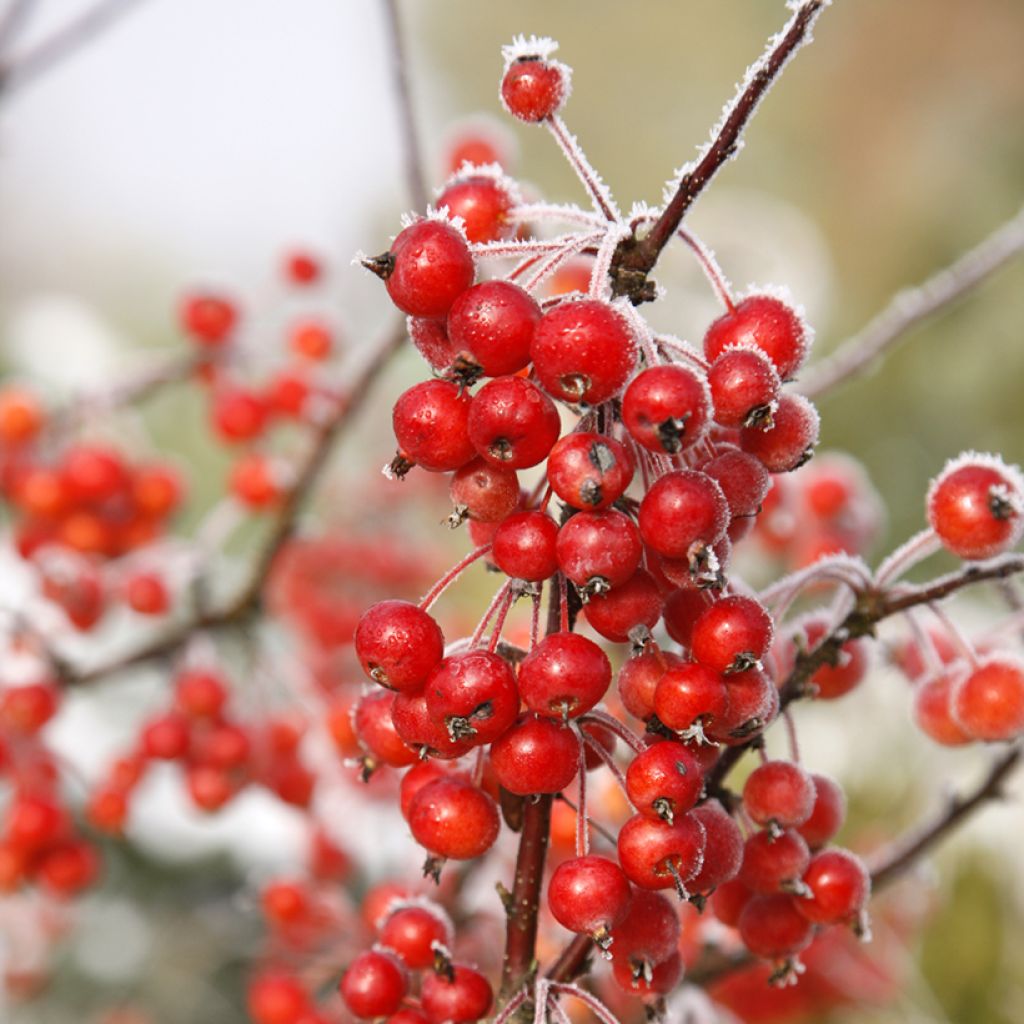

Malus POM'ZAI - Crabapple
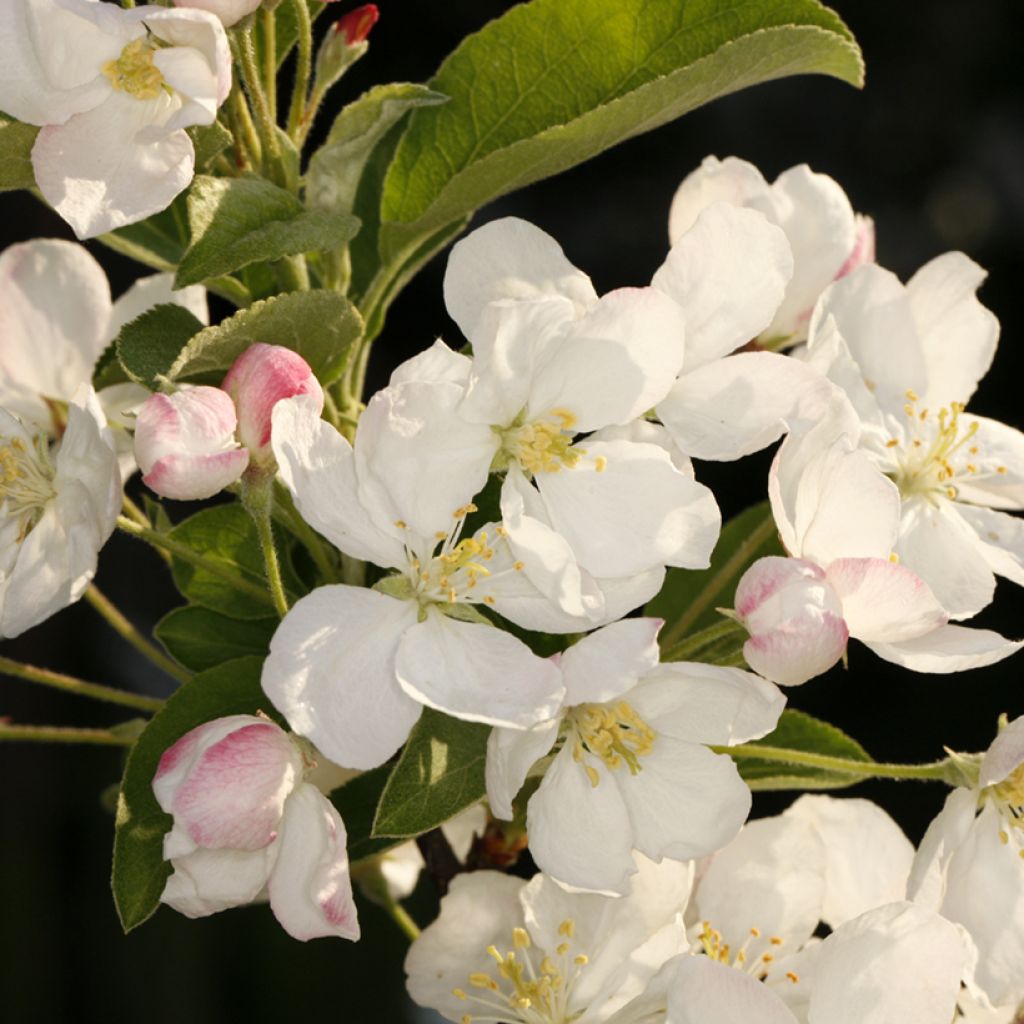

Malus POM'ZAI - Crabapple
Malus POM'ZAI - Crabapple
Malus 'Courtabri' POM'ZAI
Crabapple
This item cannot be shipped to the selected country
Delivery charge from €5.90
More information
Schedule delivery date,
and select date in basket
This plant carries a 24 months recovery warranty
More information
We guarantee the quality of our plants for a full growing cycle, and will replace at our expense any plant that fails to recover under normal climatic and planting conditions.
From €5.90 for pickup delivery and €6.90 for home delivery
Express home delivery from €8.90.
Does this plant fit my garden?
Set up your Plantfit profile →
Description
Malus POM'ZAI ® 'Courtabri' is a dwarf form of the ornamental crab apple tree Evereste® 'Perpetu' with all its qualities, but more compact for a small garden or in a medium-height hedge. In spring, this shrub forms a true ball of white flowers and pink buds. In autumn, its foliage turns yellow and orange and is adorned with a profusion of small orange fruits that will persist on the branches long after the leaves have fallen, much to the delight of birds.
Ornamental crab apple trees belong to the large family of Rosaceae. They are derived from various botanical species of the genus Malus. Many cultivars have been created in Europe, as well as in the United States, always more attractive and resistant to diseases. The Malus 'Pom'Zai' 'Courtabri' is the result of cross-breeding, with Malus floribunda among others. It is a disease-resistant plant that was selected by INRA in Paris in 1990.
'Pom'Zai' is an ideal variety for small spaces, due to its low development and slow growth. Bushy in nature, this naturally rounded and branching apple tree reaches approximately 2.50 m in all directions by the age of 15. Its leaves are ovate, arranged alternately on the branches. They are dark green and take on warm shades of yellow and orange in autumn before falling. This small apple tree displays a spectacular flowering in April, covering itself with floral buds of a lovely pink that open into pure white flowers. The single flowers with 5 petals compensate for their small size (approximately 3 cm) with their abundance: they are gathered in a multitude of small clusters that cover the entire branches. In autumn, they are replaced by fruits resembling apples, but the size of cherries (2.5 cm in diameter); they persist throughout autumn and part of winter. In some countries, they are harvested to prepare delicious jellies.
This adorable ornamental apple tree, with its modest growth, integrates easily into the garden, even in limited spaces. It can be included in a medium-height countryside hedge without the need for pruning. In a small garden, it will also be very decorative when planted alone on a lawn. It will naturally blend with other shrubs that bloom at different times to cover the entire season: forsythias, Japanese quince, Kolkwitzia 'Pink Cloud', Buddleias, and fragrant mock oranges. Also consider certain particularly vigorous roses that offer beautiful spring flowering and decorative fruiting in autumn: Rosa glauca or rubrifolia, Rugosa Rose Thérèse Bugnet, Complicata Rose...
Report an error about the product description
Plant habit
Flowering
Foliage
Botanical data
Malus
'Courtabri' POM'ZAI
Rosaceae
Crabapple
Cultivar or hybrid
Other Malus - Crabapple
Planting and care
Easy to grow in ordinary, but deep soil, Malus Pom'Zai requires a bright exposure to flower well. Ornamental Malus trees are generally very accommodating, but they prefer fertile, moist, deep soils. After careful planting and regular watering during the first two years, they can manage on their own.
Place your bush in the sun, giving it room to spread. Dig a large planting hole. If the soil is poor, add compost to the planting soil and apply fertiliser or compost to its base every spring. To prevent diseases, treat with Bordeaux mixture in spring. Lightly prune after flowering to restrict the size or shape the bush, avoiding cutting thick branches.
Planting period
Intended location
Care
This item has not been reviewed yet - be the first to leave a review about it.
Hedge shrubs
Haven't found what you were looking for?
Hardiness is the lowest winter temperature a plant can endure without suffering serious damage or even dying. However, hardiness is affected by location (a sheltered area, such as a patio), protection (winter cover) and soil type (hardiness is improved by well-drained soil).

Photo Sharing Terms & Conditions
In order to encourage gardeners to interact and share their experiences, Promesse de fleurs offers various media enabling content to be uploaded onto its Site - in particular via the ‘Photo sharing’ module.
The User agrees to refrain from:
- Posting any content that is illegal, prejudicial, insulting, racist, inciteful to hatred, revisionist, contrary to public decency, that infringes on privacy or on the privacy rights of third parties, in particular the publicity rights of persons and goods, intellectual property rights, or the right to privacy.
- Submitting content on behalf of a third party;
- Impersonate the identity of a third party and/or publish any personal information about a third party;
In general, the User undertakes to refrain from any unethical behaviour.
All Content (in particular text, comments, files, images, photos, videos, creative works, etc.), which may be subject to property or intellectual property rights, image or other private rights, shall remain the property of the User, subject to the limited rights granted by the terms of the licence granted by Promesse de fleurs as stated below. Users are at liberty to publish or not to publish such Content on the Site, notably via the ‘Photo Sharing’ facility, and accept that this Content shall be made public and freely accessible, notably on the Internet.
Users further acknowledge, undertake to have ,and guarantee that they hold all necessary rights and permissions to publish such material on the Site, in particular with regard to the legislation in force pertaining to any privacy, property, intellectual property, image, or contractual rights, or rights of any other nature. By publishing such Content on the Site, Users acknowledge accepting full liability as publishers of the Content within the meaning of the law, and grant Promesse de fleurs, free of charge, an inclusive, worldwide licence for the said Content for the entire duration of its publication, including all reproduction, representation, up/downloading, displaying, performing, transmission, and storage rights.
Users also grant permission for their name to be linked to the Content and accept that this link may not always be made available.
By engaging in posting material, Users consent to their Content becoming automatically accessible on the Internet, in particular on other sites and/or blogs and/or web pages of the Promesse de fleurs site, including in particular social pages and the Promesse de fleurs catalogue.
Users may secure the removal of entrusted content free of charge by issuing a simple request via our contact form.
The flowering period indicated on our website applies to countries and regions located in USDA zone 8 (France, the United Kingdom, Ireland, the Netherlands, etc.)
It will vary according to where you live:
- In zones 9 to 10 (Italy, Spain, Greece, etc.), flowering will occur about 2 to 4 weeks earlier.
- In zones 6 to 7 (Germany, Poland, Slovenia, and lower mountainous regions), flowering will be delayed by 2 to 3 weeks.
- In zone 5 (Central Europe, Scandinavia), blooming will be delayed by 3 to 5 weeks.
In temperate climates, pruning of spring-flowering shrubs (forsythia, spireas, etc.) should be done just after flowering.
Pruning of summer-flowering shrubs (Indian Lilac, Perovskia, etc.) can be done in winter or spring.
In cold regions as well as with frost-sensitive plants, avoid pruning too early when severe frosts may still occur.
The planting period indicated on our website applies to countries and regions located in USDA zone 8 (France, United Kingdom, Ireland, Netherlands).
It will vary according to where you live:
- In Mediterranean zones (Marseille, Madrid, Milan, etc.), autumn and winter are the best planting periods.
- In continental zones (Strasbourg, Munich, Vienna, etc.), delay planting by 2 to 3 weeks in spring and bring it forward by 2 to 4 weeks in autumn.
- In mountainous regions (the Alps, Pyrenees, Carpathians, etc.), it is best to plant in late spring (May-June) or late summer (August-September).
The harvesting period indicated on our website applies to countries and regions in USDA zone 8 (France, England, Ireland, the Netherlands).
In colder areas (Scandinavia, Poland, Austria...) fruit and vegetable harvests are likely to be delayed by 3-4 weeks.
In warmer areas (Italy, Spain, Greece, etc.), harvesting will probably take place earlier, depending on weather conditions.
The sowing periods indicated on our website apply to countries and regions within USDA Zone 8 (France, UK, Ireland, Netherlands).
In colder areas (Scandinavia, Poland, Austria...), delay any outdoor sowing by 3-4 weeks, or sow under glass.
In warmer climes (Italy, Spain, Greece, etc.), bring outdoor sowing forward by a few weeks.

































